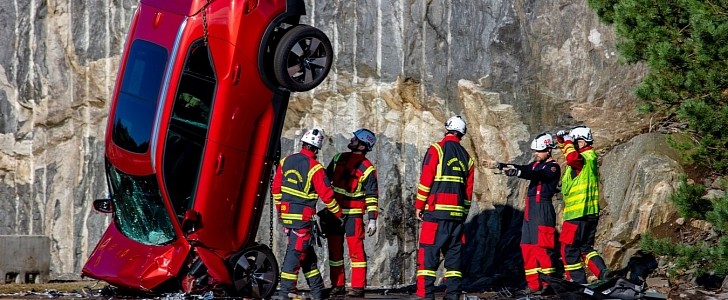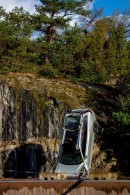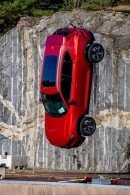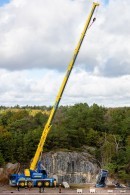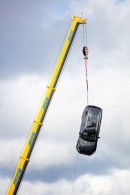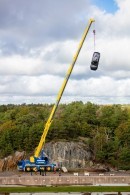Rescue workers offer talk about the so-called “golden hour,” the one-hour time interval they have to rescue a victim from a car wreck and get them to the hospital. The first part of the rescue operation, getting the victim out of the mangled car, is of the utmost importance in order to meet this life-saving deadline.
Swedish rescue workers got a helping hand from Volvo in this sense, with the carmaker donating 10 new vehicles that they crushed by dropping them from the sky. All cars were lifted to 30 meters (98.5 feet) by crane and then dropped to the ground, simulating full frontal, full lateral and T-bone collisions on the road.
This gave emergency services the perfect opportunity to work on existing rescue techniques and improve them, and to develop new, more appropriate ones. The findings of this experiment will be published in a report that will then be shared with rescue workers throughout Sweden – and maybe even worldwide, Volvo says in a press release.
As for using brand-new cars for the project, when old vehicles would have served just as well, that’s not the case. Rescue workers usually train on scrapyard stuff and it’s almost always older than two decades. In 20 years, the auto industry has evolved and changed, from the way cars are built to the materials used and safety features, and rescue workers need to be kept up to date with these developments. This is where Volvo came in.
This is the first time that Volvo performs one such crash test. In order for it to be most helpful for rescue workers, Volvo Cars safety engineers calculated the exact amount of pressure and force each vehicle would be exposed to, so as to result in the most damage.
“We have been working closely together with the Swedish rescue services for many years,” says Håkan Gustafson, a senior investigator with the Volvo Cars Traffic Accident Research Team. “That is because we have the same goal: to have safer roads for all. We hope no one ever needs to experience the most severe accidents, but not all accidents can be avoided. So it is vital there are methods to help save lives when the most severe accidents do happen.”
This gave emergency services the perfect opportunity to work on existing rescue techniques and improve them, and to develop new, more appropriate ones. The findings of this experiment will be published in a report that will then be shared with rescue workers throughout Sweden – and maybe even worldwide, Volvo says in a press release.
As for using brand-new cars for the project, when old vehicles would have served just as well, that’s not the case. Rescue workers usually train on scrapyard stuff and it’s almost always older than two decades. In 20 years, the auto industry has evolved and changed, from the way cars are built to the materials used and safety features, and rescue workers need to be kept up to date with these developments. This is where Volvo came in.
This is the first time that Volvo performs one such crash test. In order for it to be most helpful for rescue workers, Volvo Cars safety engineers calculated the exact amount of pressure and force each vehicle would be exposed to, so as to result in the most damage.
“We have been working closely together with the Swedish rescue services for many years,” says Håkan Gustafson, a senior investigator with the Volvo Cars Traffic Accident Research Team. “That is because we have the same goal: to have safer roads for all. We hope no one ever needs to experience the most severe accidents, but not all accidents can be avoided. So it is vital there are methods to help save lives when the most severe accidents do happen.”
